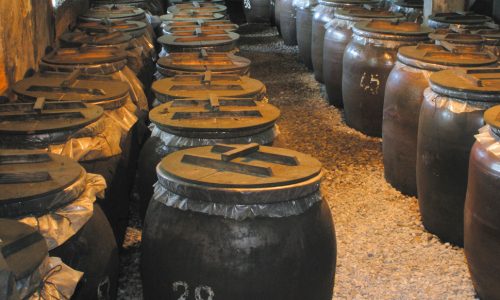
If you’re new to Awamori, the phrae “kusu” may be new to you.
After Awamori has been produced and aged for a long period of time, the composition of the Awamori itself changes, sometimes releasing a mellow, mellow aroma with a hint of sweetness. When Awamori has matured to such a state, it is called kusu. It is pronounced kūsu, and written 古酒, which means aged alcohol in Japanese.
Kusu making is practiced not only by brewers and manufacturers, but also by Awamori enthusiasts.. There are various styles of aging methods, including the most traditioal approach whc is aging it in a ceramic pot. This is simply referred to as “pot Kusu”. In this case, trace elements from the earthenware infuse the the quality of the Awamori, and the evaporation of some of the ingredients results in each batch developing a unique aroma.
The method of maturing Awamori using multiple jars is called “Shitsugi”, and it has been passed down over multiple generations as the most desirable technique for brewing stable and high quality Kusu.
On the other hand, Kusu made by aging bottled Awamori in its bottled state is called bottled Kusu.
In general, the risk of alcohol evaporation and microbial growth is lower (and thus easier to control) when Kusu is aged in glass bottles. On the other hand, it is also difficult to determine when it is ready to drink because once bottle-aged Kusu reach their peak (ready to drink), they lose their potency, making it difficult to determine the best timing for consumption.
In the case with bottle-aged Awamori, the standard drinking time is 3 to 20 years when the Awamori is 30 percent alcohol content.
When Awamori contans more than 40 % alcohol, the standard drinking time is from 3 to 20 years. Currently, there are many bottled Kusu that are considered to be before their peak, even if they are 30 years old.
When it comes to Shikitsugi Kusu, almost all of the super long aged Kusu were lost in the war, and thus the peak is unknown, but according to historical records, there used to be many 100 and 200-year-old Kusu, so it is possible to age Awamori up to approximately that length of time.
How is Kusu (Aged Awamori) Defined?
In Japan, in order to produce and sell Awamori labeled as Kusu (aged Awamori, Matured Amwamori, old Sake), its contents must be “entirely stored for a minimum of three years” according to the Fair Competition Code (Consumer protection policy).
In addition, when indicating the number of years of storage for Awamori, the same code states, “All Awamori must have been stored for a minimum of the indicated number of years. When multiple aged liquors of different ages are mixed, the age of the lowest aged liquor shall be indicated regardless of the ratio of the old liquors. Additionally, the number of years of storage shall be rounded down to the nearest year.
